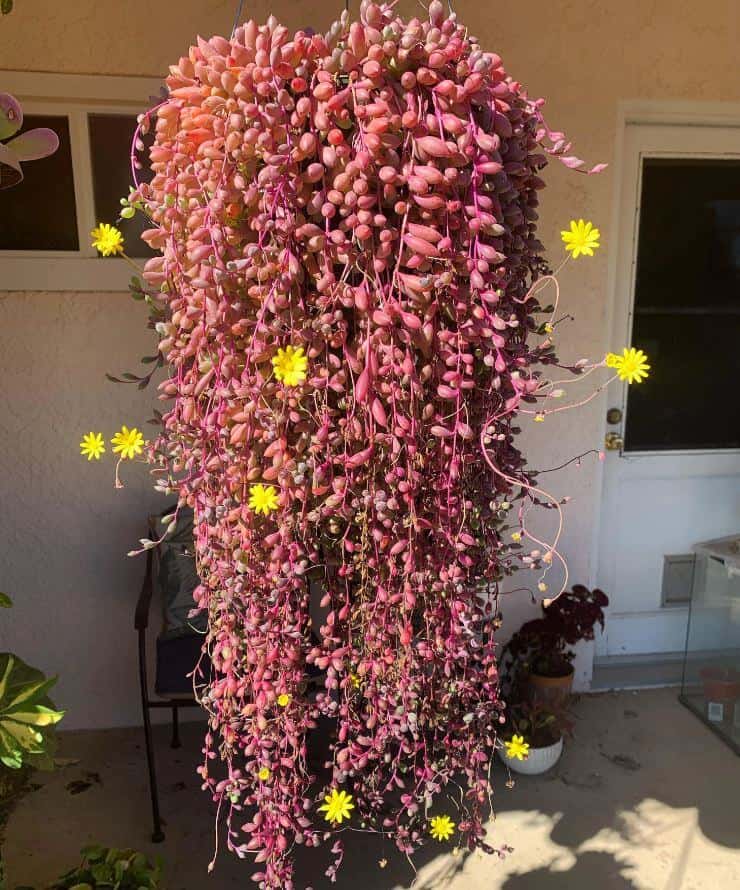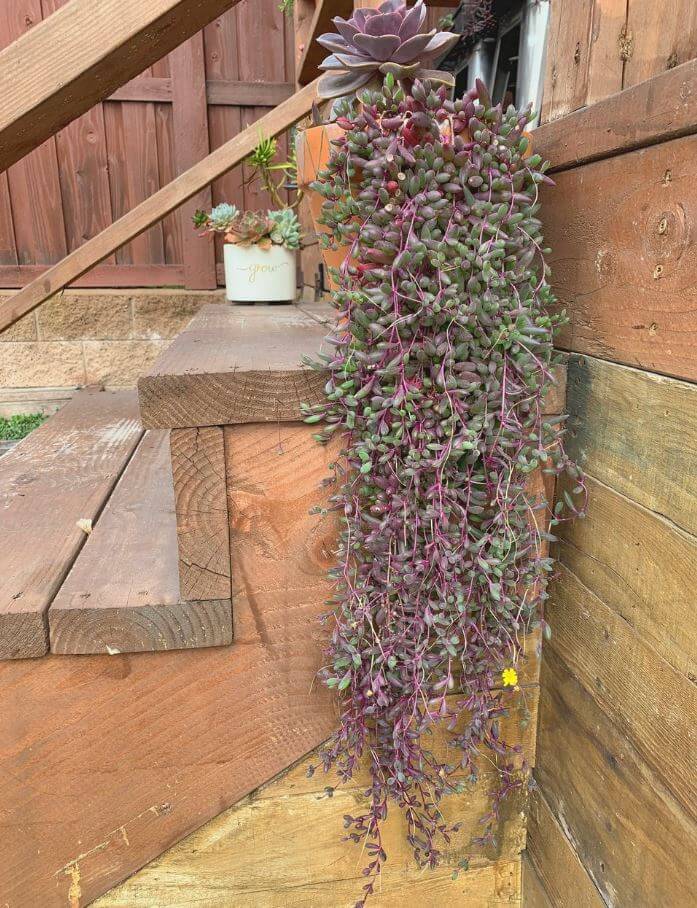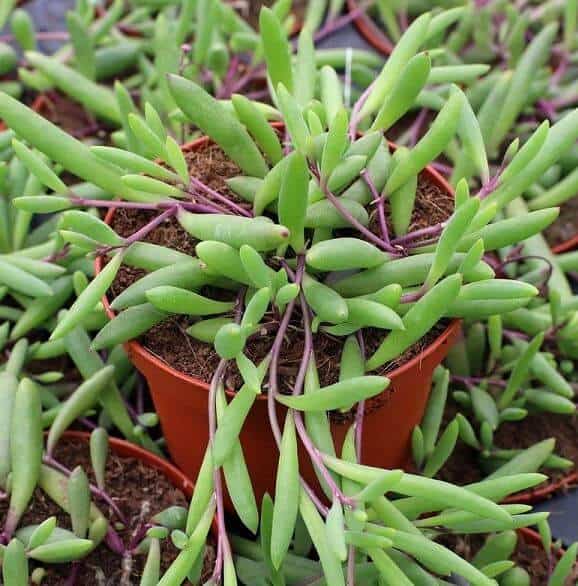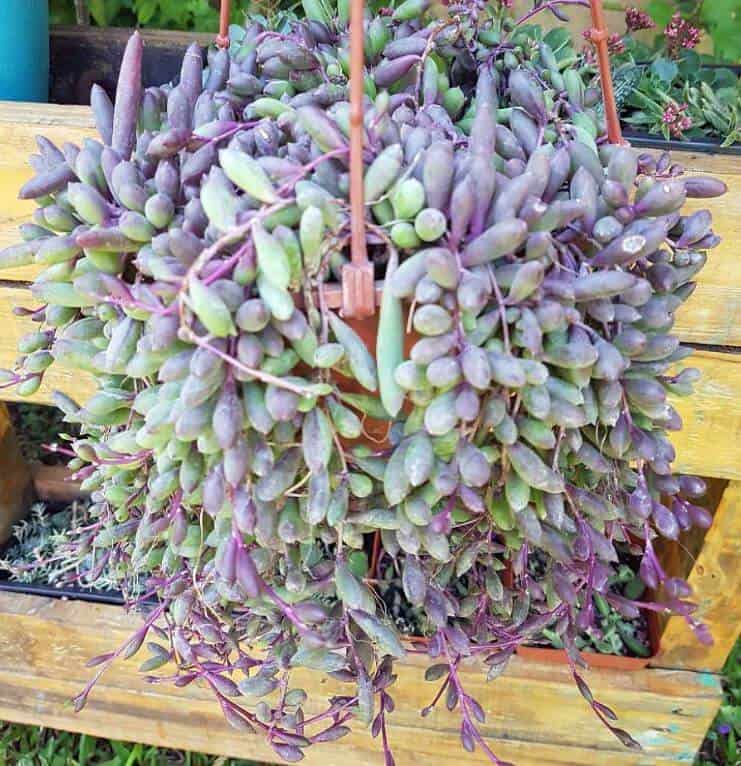Last Updated on February 18, 2023 by a Friendly Gardener
Lovers of trailing plants should consider a String of Rubies plant for their collection. The Othonna capensis is a delightful trailing succulent with lovely oval-shaped foliage and a stem in a reddish-purple hue. Also referred to as the “string of pickles” or the string of rubies necklace plant, this succulent belongs to the Asteraceae family and is related to the String of Dolphins and String of Pearls belonging to the Senecio genus.
This native of South Africa, however, has a defining characteristic that accounts for its name. When the plant is stressed, its oval-shaped leaves become vivid red. Mature plants can reach two inches in height and will produce yellow flowers when blooming during the spring, summer, and autumn seasons.
A String of Rubies Plant Care

A sun-loving succulent, the String of Rubies is easy to cultivate and care for. It can tolerate some drought thanks to moisture storage in its foliage. A generous dose of sunlight and occasional watering make for a happy and thriving plant.
Soil
As a succulent your String of Rubies needs a well-draining growing medium that has an acidic soil pH. A potting soil formulated for succulents or cacti will be best. Soil pH ideally will measure from 6 to 6.5. If you prefer to mix your growing medium blend regular potting soil with an equal amount of sand, perlite, or pumice so that good drainage is guaranteed.
Light

Ideally, a String of Rubies needs at least six hours of direct sunlight exposure when cultivated indoors. If you can provide more, that’s great. Outside it will do well in direct sunlight with some partial shade. If cultivated with full sun exposure, the bean-like leaves will turn a full red. If you locate your plant in a low-light environment, the foliage will remain green, and your plant may become leggy in its quest for light. If your growing location does not have adequate light, this plant will respond well to grow lights.
Water
The String of Rubies’ growing medium should be allowed to dry out after each watering before giving more water. Succulents in general are very much at risk for root rot should they be overwatered. Once the soil has dried out, water the plant well allowing excess water to drain completely before returning your plant to its spot. If you forget to water, don’t fret as the plant stores water in its foliage and can resist drought for an extended period.
Humidity
If you are cultivating indoors, this plant should do fine in average home humidity levels. It is important not to subject this plant to high humidity as mold and fungal infections can develop, so avoid bathrooms and kitchens in general.
Environmental Temperature
Normal home temperatures should be adequate for this tropical and subtropical plant as they prefer temps that are above 50° F. The String of Rubies plant should be protected from drafts and the cold, so avoid windows in winter unless well-insulated as well as air conditioning vents and units in the summer months.
For outdoor cultivation, this succulent does well in USDA hardiness zones 9a through 11b. If you reside in another zone, consider bringing your plant indoors when the cool weather arrives.
Feeding

The String of Rubies does not need much in terms of food, so it will not require fertilization per se. If you wish to support your plant’s growth habit, you may want to feed it once or twice in the spring and summer. When choosing a fertilizer, pick one formulated for succulents and cacti, or that has low nitrogen content. Exaggerated fertilization can burn root systems and kill the plant.
Pruning
If you want to help your plant rejuvenate or if your plant becomes leggy, prune stems at the beginning of the growing season. Never trim off more than a third of the plant when performing seasonal pruning.
Repotting a String of Rubies Plant

The String of Rubies enjoys being slightly rootbound so you mustn’t repot very often. Plan on repotting every other year or every third year. If you do repot, make sure your new container has a lot of drainage holes and only increase the container by a single size.
As a trailing succulent your plant can do well in just about any type of pot, but a clay or terracotta pot is recommended. A terracotta container will absorb excess moisture, wicking it away from the root system. Clay pots offer an extra layer of protection against overwatering.
String of Rubies Propagation

This is an easy plant to propagate through the use of stem cuttings. When you select your cuttings, ensure that they have a minimum of three nodes. To propagate this plant, water or soil can be used although soil has a better chance of success. Succulents are at risk of rotting, so water propagation can be more of a challenge.
Select a shallow plant pot and fill it with succulent or cacti growing medium. Place your stem cuttings on top of the soil mix. The soil bed should be kept a bit moist, but not overly so until roots have formed.
If you are intrigued by propagating the String of Rubies in water, remove any leaves from the bottom of the stem cutting so that the nodes are exposed. Place this end in a jar of water making sure that the nodes are submerged. A transparent container is best because you will be able to see when new roots form. Change the water once a week. When roots have developed, you can transfer your cutting to a pot with soil. Maintain moist soil for the first week to ten days so that your stem cutting does not experience transplant shock.
Pests
Like all houseplants, your String of Rubies can be susceptible to common sapsuckers that attack indoor gardens. Scale and Mealybugs are probably the more common pests to visit, so examine your plants for signs of these. Scales generally appear as brown waxy bumps on stems and leaves. Mealybugs will leave white cotton-like deposits on your plant. You can remove these insects with a cotton ball or pad with rubbing alcohol. You should then treat your plant with insecticidal soap or with a light spray of Neem oil.
Diseases
These succulents are not prone to diseases unless they are overwatered. Fungal root rot is the biggest threat.
Growth Problems
Any kind of stunted growth is indicative of an ill plant. Illness can be caused by pest infestations or be due to prolonged stress in its environment. Observe your plant to determine the cause of your plant’s difficulties and intervene accordingly.
String of Rubies Toxicity
Happily, this succulent is non-toxic for pets and humans.

